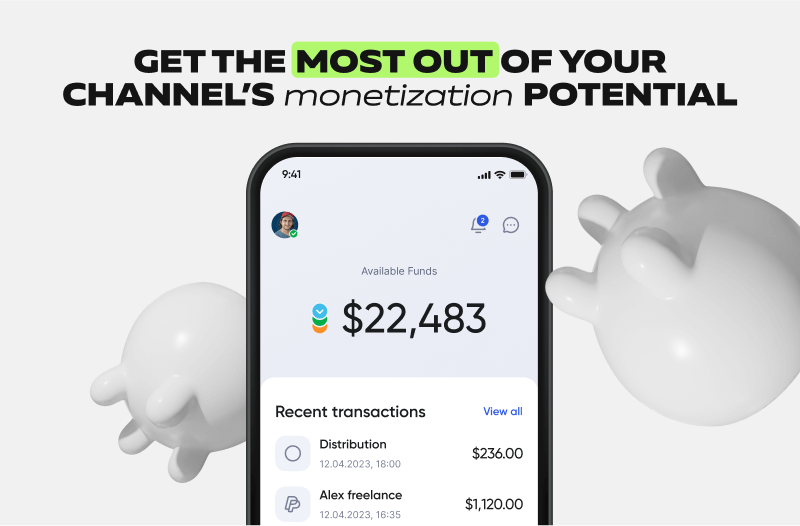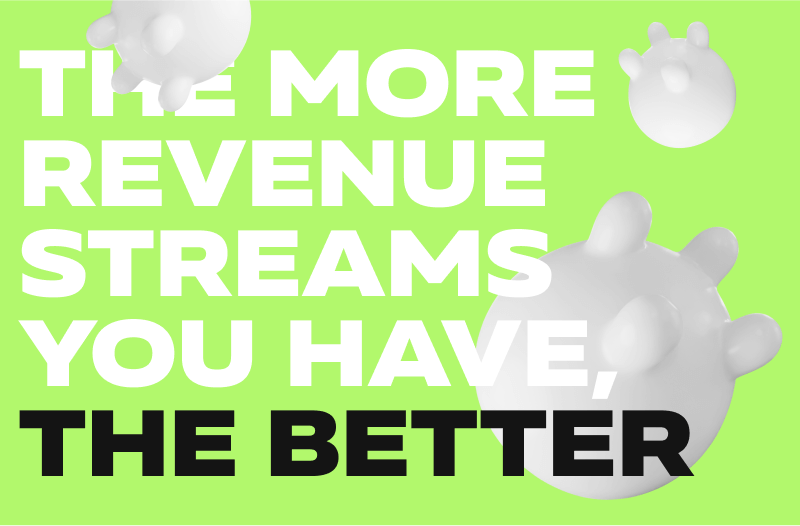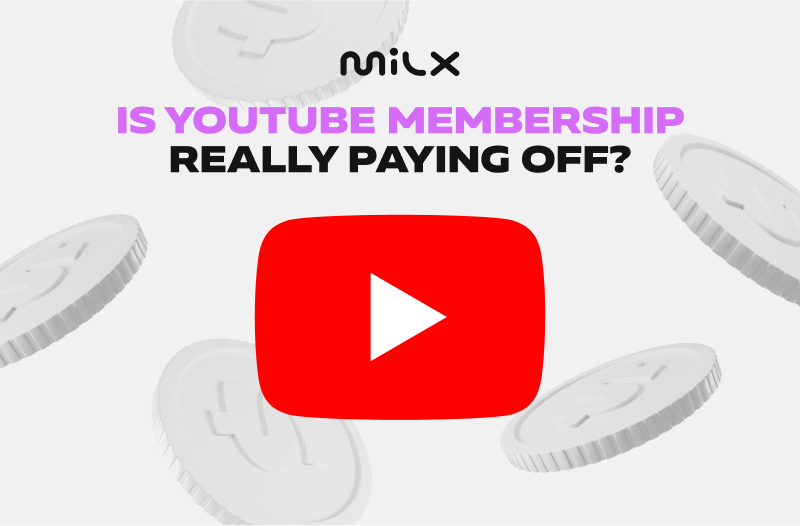“Loyalty is a decision, a resolution of the soul.” – Pascal Mercier
Since its introduction in 2018, the YouTube membership program has become an effective instrument for creators to generate additional revenue by offering loyal channel viewers unique perks in return for their support in the form of a monthly fee.
Thousands of creators have already launched their memberships successfully, boosting income by 20%, 30%, and even more. One of our partner channels made over $217,000 in one year from memberships alone, with a monthly income exceeding $20,000.
So, why are some creators still hesitant to capitalize on YouTube memberships? MilX discussed the issue with our partner channels, and here’s what we found out.

This Is Why Creators Stick to Ad Revenue and Call It a Day
Getting out of your comfort zone is nerve-wracking, we get it.
Assuming you’re a full-time YouTuber with 100,000 monthly views, your estimated AdSense earnings have to be around $500-$1,500 per month.
Are you satisfied with these figures? Is it enough to provide for a living? Because it’s hardly enough to reinvest in the channel even.
Reinvesting the money you make on YouTube is essential for growing your channel. But what if you can’t wait till the end of the month when the ad payment is due? With MilX, you can access your earnings immediately, not when YouTube decides.
So, let’s be honest and say it: “I have to explore additional avenues to increase my revenues!”
YouTube memberships are an excellent way to monetize your existing audience. However, the pains of growing are real. We asked our partners about the key hesitation points when considering YouTube’s subscription-based feature, and here’s what they said:
- "No one’s gonna pay for this." (Oh, they WILL pay!)
- “I don’t want to mess up my ad revenue.” (Read on and see for yourself that you won’t.)
- “Too much extra work." (It’s less than you think, actually.)
- "Feels weird asking for money." (You’re giving exclusive content in return, so it’s a fair and square deal.)
- "Gotta grow first." (Chance are, you can start memberships right away.)
- "I already use Patreon." (Memberships are more lucrative.)
Such reluctance is understandable. But we believe that once you make an effort to explore memberships, this will be one of the best decisions for your channel ever made.
Why Relying Solely on Ad Revenue Is a Bad Idea?
For every YouTube creator, becoming eligible for ad revenue is a major milestone.
However, AdSense has its drawbacks and limitations, which force creators to search for additional revenue streams:
|
Sudden drops in traffic |
Every creator who’s been doing YouTube for at least a year knows the feeling when their channel’s traffic drops all of a sudden without any explanation. |
|
Relying on ads too much |
YouTube is known for CPM fluctuations, seasonal trends, and algorithm changes. As a result, ad revenue may plummet, leaving you with zero backup plan. |
|
Demonetization |
It’s difficult to apply for ad revenue, but it’s very easy to lose it. A single yellow dollar sign and poof—your AdSense income is gone. |
|
Competition is tough |
New creators join YouTube all the time, so it becomes harder to spot a niche with a high CPM, as well as compete with other YouTubers within your niche. |
At this point, every sign is pointing at one thing—you can’t sit on ad revenue alone. You can make $1000 from ads, but if your goal is $10,000 a month, AdSense, with all its handicaps and stumbling blocks, is not enough.

The Next Big Thing for Your Channel’s Monetization
For a creator who has already joined the YouTube Partner Program (YPP), reached 1,000 subscribers, and ticked all the other eligibility boxes, setting up the membership program becomes the next big step in growing the channel.
Typically, 1-2 % of your subscribers become members. So, if you have 100,000 subscribers, you could expect around 1,000 to 2,000 members.
With a basic membership costing $4.99/month, you could earn $4,990 before YouTube's cut—30%.
“But I Already Have a Patreon Account”
Indeed, 70% of creators have already established a Patreon or Buy Me a Coffee account to get support from loyal followers. With a following of 30,000 people, a creator can make about $300-$1,500 a month.
So why set up memberships when you already have subscribers on another platform? It’s a simple math—having two subscription-based revenue streams is better than one.
Here’s a case of one of MilX’s partners, an entertainment channel with 67K subscribers, that successfully utilized Patreon and then decided to explore YouTube memberships for additional revenue.
In April, they started the YouTube feature for subscribers, incorporating tiers and bonuses from their Patreon account. This allowed the author to attract new sponsors and increase channel revenue by 17% in the first month and 24% in the second month after activating Membership.
In addition to increasing revenue, the membership feature helped the creator enhance engagement on the channel through exclusivity and connect with a dedicated audience of fans who actively engage, inspire, and contribute to content creation.
Have you already started to think up brilliant content ideas for your channel’s members, but need funds to get things running? MilX will be happy to fuel your vision with upfront cash.
Success Cases of YouTube Memberships From MilX
A smart content creator never puts all eggs in one basket.
Even top creators are on a constant lookout for ways to increase their revenue, so the hassle never stops for small, medium, and big channels alike.
Below, we’ve gathered several success cases of how creators increased their revenue by establishing memberships on YouTube.
Business Channel with a Political Take
- Subscribers: 130K
The channel started to use memberships and Super Features to support its mission of explaining the situation in Ukraine to English speakers.
Within one year, these features have generated over 26% of the channel’s YouTube revenue, thanks to 14.8% of viewers becoming subscribers.

Big News Channel
- Subscribers: 928K
This channel has been using the YouTube membership feature since April 2022, which constituted 30% of the income.
The creator behind the channel relies on the membership program to turn off certain ad types, preventing audience overload while continuing to monetize during times when YouTube restricts traditional ads.
Membership has become a vital income stream, accounting for a third of YouTube monetization revenue, ensuring sustained support despite limited ad revenue.
Political News Channel
- Subscribers: 489K
This channel aims at conveying Ukraine’s position to the Russian-speaking audience. 52% of the channel's audience doesn't have commercial value, as YouTube's monetization feature is blocked in russia.
To grow the channel, the creator harnesses alternative monetization methods on YouTube, such as memberships and Super Tools. Through Super Chat, Super Stickers, and Super Thanks, the creator generates income during regular channel streams.
This strategy generates over 50% of the total channel revenue on YouTube.
Popular History Channel
- Subscribers: 859K
The owner of this channel wished to boost their overall revenue without too much effort.
Since adopting memberships in March, it has steadily contributed to 10% of the channel’s revenue.
This income stream has been particularly valuable for the creator, as it doesn’t require additional time or excessive tweaking. Fast-forward to today, the channel’s owner plans to further enhance memberships by offering voting perks for the members to have a say in the monthly content topics.

Cumulative Effect of AdSense and Memberships
Now, it’s time to talk numbers.
For 1,000,000 monthly views, a YouTuber can expect $3,000 in ad revenue with an average RPM of $3.
Now, let’s assume just 1% of the audience (10,000 subscribers) joins a $4.99/month membership tier. As YouTube takes its 30%, the total membership revenue is $34,900.
That’s a 10x boost in earnings just by adding memberships!
Even if only 0.5% of subscribers (5,000 members) joined, that’s still $17,450 per month—far more worthwhile than ad revenue alone.
Managing payments from multiple income streams might also be challenging for a solo YouTuber. So, if you’re struggling with taxes, fees, or team payments, MilX can help you streamline all your financial operations, allowing you to focus on what you do best—create great YouTube content!
Managing Multiple Revenue Streams Is a Pickle
Taking care of your ad revenue payments is challenging in its own right.
And once you throw in an additional income stream like memberships, managing not one but two earning pools will complicate things to a greater extent.
Currency Conversion & Hidden Fees
YouTube pays in local currency, but currency conversion fees apply when withdrawing to PayPal or bank accounts, or when your currency is different from USD.
Receiving payments in USD, creators in other countries might lose 2-5% in conversion fees. Typically, YouTube’s internal conversion rate is 1-3% lower than the actual exchange rate.
- EXAMPLE: A U.K. creator, who earns $1,000 in ad revenue, loses $10 to $30 on conversion alone.
Bank transfer fees also reduce the final payout. If a YouTuber withdraws funds via PayPal, they pay a 2.9% fee + a fixed amount per transaction.
- EXAMPLE: Bank transfers can charge $15-$50 per transfer + 2-4% currency conversion fees.
There are also double conversion fees from PayPal and banks.
- EXAMPLE: A Brazilian creator gets paid in USD, but their bank converts it to BRL at a 3-5% lower rate.
On a $1,000 payment, a creator loses an extra $30-$50.
There’s No Point in Losing Money You Worked So Hard For
The more you earn, the more you lose on fees. But with MilX, it doesn’t have to be like that!
- Instantly monitor your earnings and manage payments effortlessly.
- Get paid in over 45+ national currencies that suit you best.
- Transfer your YouTube earnings into popular cryptocurrencies with ease.
Download the MilX app today and keep every dollar from YouTube revenue at your fingertips.

